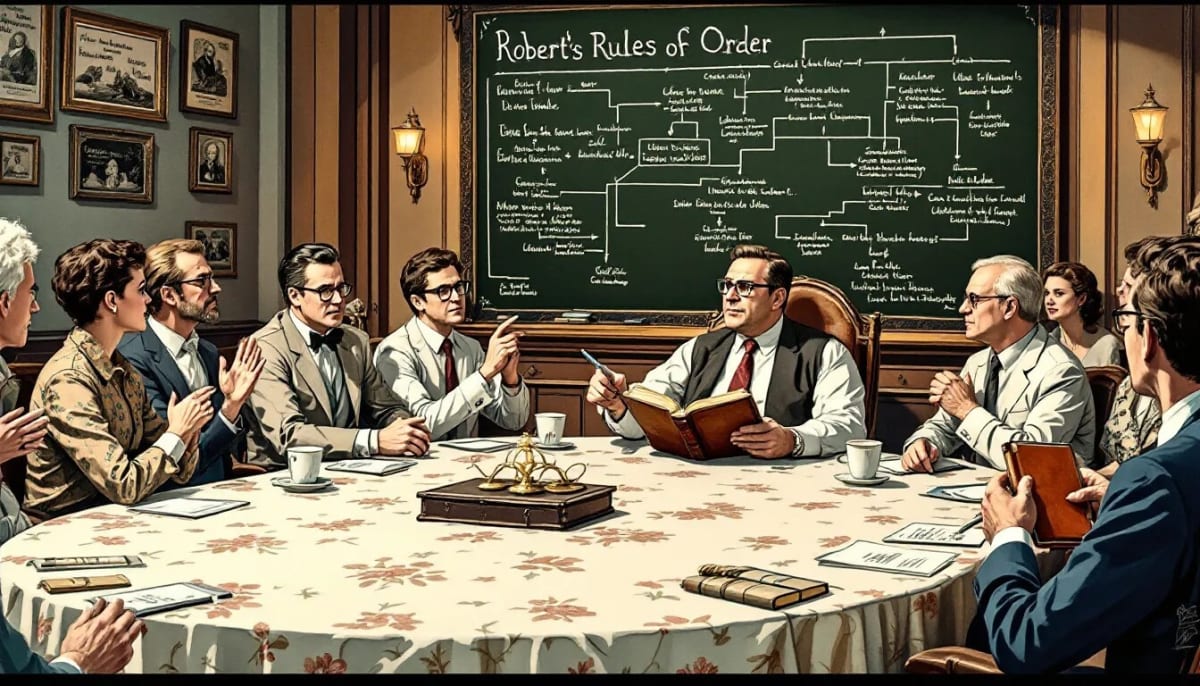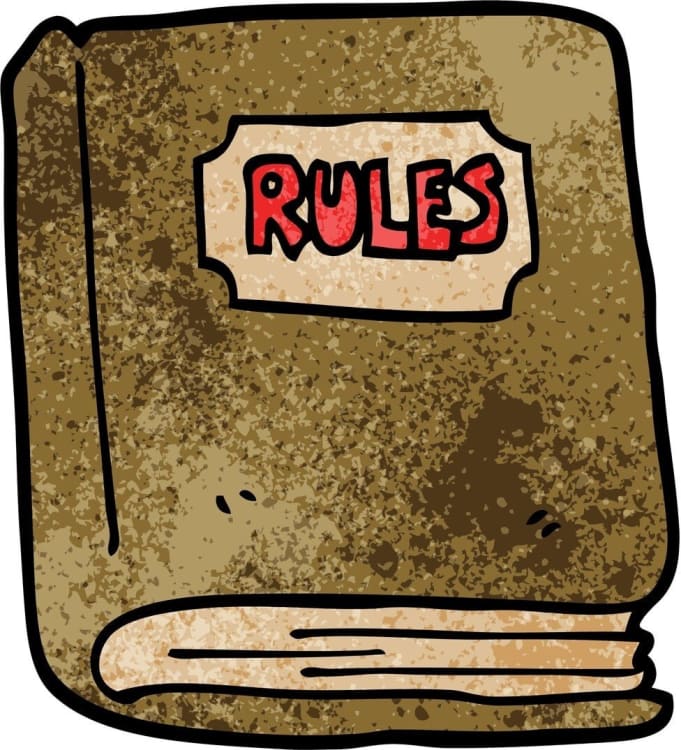If you've ever sat through a chaotic meeting with no clear direction, you’re not alone. That’s where the Roberts Rules Association comes in. Originally created by General Henry Martyn Robert, Roberts Rules of Order is a time-tested guide that helps keep meetings fair, organized, and productive.
Whether you're voting on a motion or planning the next meeting, these rules ensure that everyone gets a voice and that decisions reflect a true majority vote, while still respecting minority opinions. In this article, we’ll break down the core principles and show you how using Roberts Rules can bring structure, clarity, and inclusiveness to your team meetings.
Key Takeaways
- Robert’s Rules of Order, established by General Henry Martyn Robert, is essential for orderly and inclusive meetings, prioritizing both majority rule and minority rights.
- Key principles for effective meetings include having a clear agenda, maintaining decorum, and allowing full participation from all members to promote a focused and respectful discussion environment.
- Accurate documentation of meeting minutes is crucial, serving as an official record of decisions made and ensuring transparency and accountability within organizations.
Understanding Robert's Rules of Order

Robert’s Rules of Order, established by General Henry Martyn Robert, is a cornerstone of modern parliamentary procedure. Its primary purpose is to ensure orderly meetings where majority rule prevails while protecting the voices of the minority. This manual, which spans around 700 pages, offers detailed guidelines for conducting meetings and maintaining decorum. By following these rules relating to organizations, they can prevent off-topic discussions and protect the rights of all participants. General Robert published these rules to help facilitate effective governance.
Robert’s Rules of Order is the most commonly used parliamentary procedure, especially among nonprofit boards, committees, and established groups. Many organizations adopt these rules because they provide a structured and productive environment for decision-making. For board members, familiarizing themselves with the basics of Robert’s Rules is crucial for effective participation. Cornell University even published a simplified version highlighting three key principles for effective meetings, as endorsed by the Robert’s Rules Association.
Without clear ground rules (like those outlined by the authorship team behind Robert’s Rules) meetings can easily become dominated by a few voices, especially in fast-paced electronic meetings. This trusted framework helps keep discussions on track and encourages balanced participation. When a member makes a motion or raises a point, Roberts Rules ensures their input is heard and considered, creating a more inclusive and productive environment for everyone involved.
Key Principles of Parliamentary Procedure
Robert’s Rules of Order was first created in 1876 by General Henry Martyn Robert as a modification of congressional rules to facilitate organized meetings. It serves as a common framework for nonprofit boards, committees, and other organized groups. The primary aim of Robert’s Rules, now in its third edition, is to support orderly discussions and decision-making that respect both majority and minority opinions.
The principles of majority rule and minority rights are fundamental to democratic governance. While decisions are made based on the majority’s preference, the rights of the minority are also safeguarded. This balance fosters trust and participation in democratic institutions, ensuring that all voices are heard and respected. It’s this delicate balance that makes Robert’s Rules so effective in managing meetings.
Parliamentary procedure aims to enable assemblies to conduct their business effectively while safeguarding members’ rights. Every member has the right to participate in discussions, propose motions, and vote, fostering an inclusive decision-making environment. This inclusive approach is what sets Robert’s Rules apart as a robust tool for governance.
Basic Rules for Conducting Meetings

A clear agenda, shared in advance, is key to running efficient and focused meetings. It helps prevent confusion, ensures every detail is addressed, and sets the stage for productive discussion. Following a brief Roberts Rules summary, or referencing a particular edition of Roberts Rules of Order, can provide structure and consistency, especially in more formal settings.
Focusing on one main motion at a time keeps the meeting clear and manageable, giving each issue the attention it deserves. Typically, only members who are present can vote, reinforcing the importance of participation and engagement.
Respect and decorum are essential. The chair should remain neutral, and members are expected to follow established protocols. By sticking to Roberts Rules of Order, organizations can ensure their meetings are fair, orderly, and inclusive for all participants.
Making Motions in Meetings
A motion is a formal proposal by a board member to initiate action or express an opinion during a meeting. Any participant can make a motion, provided they follow the established procedure, making it a fundamental part of meetings under Robert’s Rules of Order.
To make a motion in an assembly:
- A member must request and be granted the floor by the chair.
- Once they have the floor, they can propose their motion.
- For consideration, the motion must be seconded by another member, ensuring it has some support before taking up the assembly’s time.
Handling a motion involves making the motion, seconding it, and debating. If a member objects, they should request a debate, followed by a vote, with the chair announcing the result. This structured approach ensures fair consideration of all motions and orderly meetings.
Types of Motions
Motions are categorized into six types, each serving specific functions. Main motions introduce new business when no other motion is under consideration, serving as primary tools for advancing the agenda and making decisions.
Secondary motions, including subsidiary and privileged motions, allow for modifying or temporarily setting aside the main motion. For example, a privileged motion addresses urgent matters requiring immediate attention, even if they interrupt ongoing discussions. Understanding these incidental motions is crucial for effective meeting participation.
Debate and Voting Procedures

Voting methods include voice, show of hands, and ballot, chosen based on the assembly size and decision nature. For sensitive issues, ballot votes ensure confidentiality. Absentee voting, including mail and proxy voting, allows participation even when members cannot attend physically.
Polling apps streamline voting in virtual meetings, making engagement easier. Clear guidelines for interruptions allow urgent matters to be addressed without disrupting flow. Contrary to belief, shouting ‘Question!’ does not halt debate; formal recognition from the chair is required before closing debate.
Decisions and voting rules include:
- Decisions can only be reversed under stricter conditions than initial approval.
- The chairperson can decide if a vote needs to be retaken in case of uncertainty.
- A two-thirds vote is required for motions modifying established rules or limiting debate.
- General consent can expedite routine business without formal voting if no member objects.
Amendments to Motions
Amending a motion involves the same steps as proposing the original motion: seconding, debate, and majority vote. Amendments can enhance the original motion during discussion but must be relevant, ensuring they directly relate to the main motion.
Key points about amendments and voting procedures:
- Amendments that change the motion type or are irrelevant are not allowed.
- Voting on an amendment occurs before the main motion.
- This allows modifications to improve the proposal before final approval.
- Adoption of an amendment requires a majority vote.
Secondary amendments can modify a primary amendment, but further amendments beyond secondary are not permitted.
Role of the Chairperson
The chairperson announces responsibilities during the meeting include:
- Calling the meeting to order at the scheduled time.
- Announcing the order of business.
- Recognizing members who wish to speak.
- Ensuring discussions remain orderly and within assembly rules to meet assembly standards.
The chairperson’s responsibilities include:
- Rejecting frivolous motions that disrupt the meeting.
- Avoiding dominating discussions and allowing ample opportunity for member participation.
- Adjourning the meeting in emergencies if it is unsafe to continue.
When making decisions, the chairperson should refrain from using personal pronouns, referring to ‘the chair’ instead. While there’s a belief that the chairperson has total control, the assembly ultimately makes procedural decisions.
Effective Meeting Tips for Board Members

Key principles for successful board meetings include:
- Having a specific and clear agenda to prevent confusion and keep discussions on track.
- Maintaining respect and decorum to ensure fair discussions and a focused environment.
- The chair encourages active participation and promotes opportunities for all members to voice their opinions.
New board members should quickly learn the basics of Robert’s Rules to participate effectively. Following the established order newly revised of precedence in discussions helps streamline decision-making processes.
Using Robert's Rules in Virtual Meetings

Robert’s Rules of Order help maintain meeting structure and focus, especially in virtual gatherings. These rules provide steps for structured meetings, ensuring clarity and organization, and clarifying agenda items, speakers, and the decision-making process, enhancing meeting efficiency.
Robert’s Rules are useful for virtual meetings because they:
- Address distractions and the lack of nonverbal social cues.
- Use polling apps and digital approaches to streamline voting.
- Employ AI tools to assist with note-taking, allowing participants to concentrate on discussions.
Platforms like Kumospace and Slack can help teams adapt Robert’s Rules of Order to modern workflows. With Kumospace’s dynamic, spatial interface, teams can share agendas, stay focused, and follow structured meeting protocols more naturally, especially during electronic meetings.
Roberts Rules of Order prevents interruptions by guiding participants to speak in turn and stay on topic. Keeping discussions to one subject at a time and limiting debate time promotes clarity and efficiency. Combined with tools like Kumospace and smart automation, teams can run more effective, inclusive, and organized meetings, whether in person or virtual.
Importance of Meeting Minutes
Decisions made during meetings must be accurately documented in the minutes, the official record of what transpired. Effective minutes should be clear, organized, and easily navigable to assist readers in finding relevant information later.
The first paragraph of the minutes should include details about the type of meeting, organization name, date, time, and location. Corrections to previous minutes should be noted in the minutes being corrected, without detailing them in the new minutes. The secretary’s signature authenticates the minutes, establishing them as the legal record.
Minutes are typically approved at the start of the next meeting, ensuring accuracy before proceeding with new business.
Common Misconceptions About Robert's Rules
A common misconception is that rules need to be the same for all meetings; however, meeting size affects procedural requirements. Another is that the chairperson lacks voting rights; in reality, the chairperson can vote like any member. Understanding these misconceptions helps clarify proper procedures and roles within meetings.
Understanding these misconceptions helps clarify proper procedures and roles within meetings.
Alternatives to Robert's Rules of Order
Several alternatives exist with different procedures for conducting meetings at the American Institute. About 5% to 15% of U.S. organizations use alternatives to Robert’s Rules of Order.
Several parliamentary procedure manuals include:
- Jim Lochrie’s ‘Meeting Procedures’: a user-friendly alternative to Robert’s Rules, used by several municipal councils.
- Demeter’s Manual of Parliamentary Law and Procedure: emphasizes simplicity in rules.
- Riddick’s Rules of Procedure: another parliamentary authority, focusing on similar principles as Robert’s Rules.
Consensus decision-making is an alternative approach where discussions precede formal proposals and modifications until agreement is reached. Atwood’s Rules for Meetings and Democratic Rules of Order are less common options organizations may consider.
Summary
Mastering Robert’s Rules of Order doesn’t require memorizing every detail, it just takes a solid understanding of the basics and a commitment to fair, structured discussion. Whether you're running board meetings, team check-ins, or virtual gatherings, applying these rules can transform the way your group makes decisions.
By following the guidance of the Roberts Rules Association, ensuring motions are clear, and respecting both majority vote and minority voices, your meetings will become more focused, inclusive, and effective. Start with a simplified approach, and watch your meetings run smoother, every time.
The primary purpose of Robert's Rules of Order is to facilitate orderly meetings that uphold majority rule while safeguarding the rights of minority opinions. This structure enables productive and fair decision-making within groups.
Yes, the chairperson can vote in meetings conducted under Robert's Rules, just like any other member.
Robert's Rules facilitate a structured and organized approach in virtual meetings, helping to minimize distractions and ensuring that all participants have a chance to contribute effectively. This framework enhances engagement and productivity during discussions.
Motions in Robert's Rules are classified into six types: main motions, secondary motions (which comprise subsidiary and privileged motions), and incidental motions. Understanding these categories helps ensure effective meeting management and decision-making.
Meeting minutes are essential because they provide an official record of decisions and actions, promoting transparency and accountability among participants. This documentation helps to prevent misunderstandings and keeps everyone informed.





